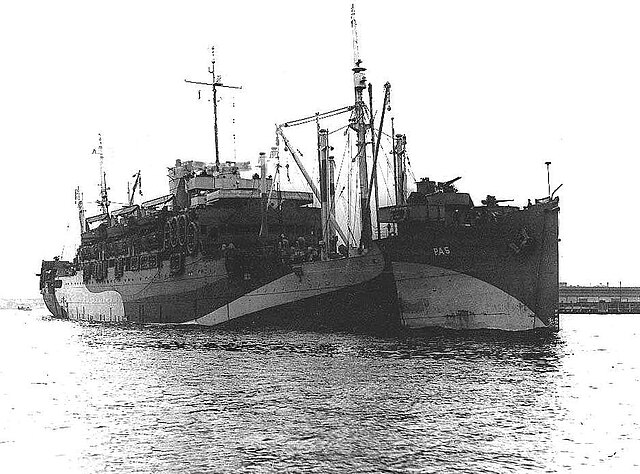Loading AI tools
Convoys during naval battles of the Second World War From Wikipedia, the free encyclopedia
The UG convoys were a series of east-bound trans-Atlantic convoys from the United States to Gibraltar carrying food, ammunition, and military hardware to the United States Army in North Africa and southern Europe during World War II. These convoys assembled in Hampton Roads near the mouth of Chesapeake Bay and terminated in various North African locations as Axis forces retreated from 1942 through 1945.[1]


Allied war materials had been transported from North America to the British Isles in HX convoys since 1939 and in slower SC convoys since 1940. These convoys were escorted by the Royal Navy and Royal Canadian Navy. The United States Navy provided a few escorts to HX and SC convoys from September 1941 through April 1943. UG convoys were established as a second, more direct, supply route to support the invasion of North Africa. The first convoy, designated UGF 1, was the invasion convoy sailing on 24 October 1942 and arriving on 8 November 1942. The F designated a convoy of faster ships. Thereafter, fast and slow eastbound and westbound convoys on this southern route were given four separate numbering sequences beginning with 2.[1]

Commencing with UGF 2, sailing New York 6 November 1942, fast eastbound convoys were sailed along the southern trans-Atlantic route at irregular intervals of about 25 days until June 1943. Convoys UGF 2 and UGF 3 terminated in Casablanca, and the termination point was extended into the Mediterranean port of Oran with convoy UGF 4. In preparation for the Allied invasion of Sicily, convoys UGF 8 and UGF 9 sailed in two sections with the second section being identified as UGF 8A and UGF 9A, respectively. Sailing frequency to the Mediterranean was then reduced by preparations for Operation Overlord. Convoy UGF 10 was the last convoy terminating at Oran on 2 September 1943; and convoy UGF 11 was the first reaching the southern European port of Naples on 31 May 1944. With UGF 12 sailing Hampton Roads 1 July 1944, the interval was set at 27 days, at which it remained the rest of the war. This schedule called for two escort groups based at Norfolk and two convoy commodores.[2] Separate convoys designated UGF 15B and UGF 17B terminated in Marseilles. The last fast eastbound convoy UGF 22 terminated in Oran on 8 April 1945. A total of 382 ships sailed in 26 fast convoys, and none were lost.[1]
Approximately two slow eastbound convoys per month departed Hampton Roads along the southern trans-Atlantic route beginning with convoy UGS 2 on 13 November 1942. Frequency of sailing increased to three convoys per month in the summer of 1943 and increased again to six convoys per month in 1945. The last slow eastbound convoy, UGS 95, left Hampton Roads on 28 May 1945. Approximately 5800 ships sailed in 100 slow convoys. Additional sections were identified as UGS 5A, UGS 6A, UGS 7A, UGS 8A, UGS 33A, and UGS 55B.[1]
Convoy UGS 6 came under attack by wolf packs Unverzagt, Wohlgemut, and Tummler during the submarine offensive including the battle of convoys HX 229/SC 122. Three ships were sunk:[3][4]
These were the only ships lost during the Atlantic crossing of these convoys, although the following ships were lost in the Mediterranean Sea:[4]


A total of 335 ships returned to the United States along the southern trans-Atlantic route in 24 fast convoys beginning with the sailing of convoy GUF 2 from Casablanca on 29 November 1942. The last fast westbound convoy GUF 22 left Oran on 16 April 1945. Additional sections were identified as GUF 2A, GUF 15B, and GUF 17B. No ships were lost from these fast convoys.[1]
Approximately 5200 ships returned to the United States along the southern trans-Atlantic route in 98 slow convoys beginning with the sailing of convoy GUS 2 from Oran on 21 December 1942. The last slow westbound convoy GUS 92 left Oran on 27 May 1945. Additional sections were identified as GUS 5A, GUS 5B, GUS 6A, GUS 7A, GUS 8A, GUS 10X, and GUS 55B.[1] There were no losses from these convoys during the Atlantic portion of their voyage, but five ships were lost within the Mediterranean Sea:

The United States Navy provided all escorts between Hampton Roads and Gibraltar, although some of the destroyer escorts providing anti-submarine screens for these convoys had United States Coast Guard crews. A typical screen was provided by an escort division (CortDiv) of six destroyer escorts.[10] Most of these convoys were given air coverage from escort carriers and patrol bombers flying from the Azores. The Royal Navy initially provided escorts within the Mediterranean, although United States escorted these convoys as far as Oran as the front moved east.[1]
![]() Media related to UG convoys at Wikimedia Commons
Media related to UG convoys at Wikimedia Commons
Seamless Wikipedia browsing. On steroids.
Every time you click a link to Wikipedia, Wiktionary or Wikiquote in your browser's search results, it will show the modern Wikiwand interface.
Wikiwand extension is a five stars, simple, with minimum permission required to keep your browsing private, safe and transparent.